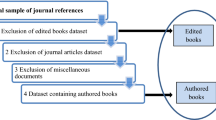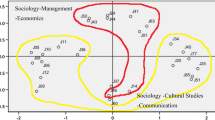Abstract
This study investigates Ted Nelson’s works and the influence of his hypertext concept through citation analysis, including citation counting, characteristics of citing articles on language, document type, citing year, discipline, and citation content. The selection of the Nelson’s works was based on searching Library Literature & Information Science, Library and Information Science Abstracts, Google and Yahoo search engines. The citation data were compiled from the database of Web of Science. The results of the study reveal that hypertext has directly great impact on information retrieval and world wide web; therefore, the concept has had profound influence on information, library and computer science disciplines. Moreover, the influence of Nelson’s works spreads to other disciplines variously, especially on education, literature, business and economics, engineering, sociology, psychology, etc. The citation context analysis of citing articles on information and library science reveals that (1) definition, orientation and general introduction of hypertext; (2) relation of Vannevar Bush and Ted Nelson in terms of hypertext; (3) Nelson’s Xanadu system and its component of hypertext; (4) the application of hypertext in information science and library science are four most citing purpose.
Similar content being viewed by others
References
T. H. Nelson, (2005). (http://www.sis.pitt.edu/~mbsclass/hall_of_fame/nelson.htm) (2005/05/13).
K. Arnold, Virtual transformations: The evolution of publication media. Library Trends, 43(4) (1995) 612.
L. C. Smith, “Memex” as an image of potentiality in information retrieval research and development. In: R. N. ODDEY & al. (Ed.), Information Retrieval Research, Butterworths, London, 1981, p.357.
http://www.livinginternet.com/w/wi_nelson.htm (2006/03/17)
P. L. K. Gross, E. M. Gross, College libraries and chemical education. Science, 66(1927) 385–389.
H. Cason, M. Lubotsky, The influence and dependence of psychological journals on each other. Psychological Bulletin, 33 (1936) 95–103.
L. Wispe, C. Osborn, Citation patterns in communication: a study of interdisciplinary influences. Association for Communication Administration Bulletin, 42 (1982) 32–39.
H. D. White, K. W. McCAin, Visualizing a discipline: An author co-citation analysis of information science, 1972–1995. Journal of the American Society for Information Science, 49(4) (1998) 327–355.
T. A. Brooks, How good are the best papers of JASIS? Journal of the American Society for Information Science, 51(5) (2000) 485–486.
M. R. Bagby, J. D. Parker, A. S. Bury, A comparative citation analysis of attribution theory and the theory of cognitive dissonance. Personality and Social Psychology Bulletin, 16 (1990) 274–283.
F. W. Lancaster, S. Bushur, Y. M. Low, Kochen’s influence examined bibliometrically. Library Trends, 41(4) (1993) 549–566.
M. Spasser, The enacted fate of undiscovered public knowledge. Journal of the American Society for Information Science, 48(8) (1997) 707–717.
S. E. Cozzens, What do citations count? The rhetoric-first model. Scientometrics, 15 (1989) 437–447.
M. J. Moravcsik, P. Murugesan, Some results on the function and quality of citations. Social Studies of Science, 5 (1975) 86–92.
LISA: Library and Information Science Abstracts on Silver Platter Manual, 2003.
LLIS: Library Literature and Information Science, 2005. (http://www.hwwilson.com/databases/liblit.htm) (2005-05-02).
T. H. Nelson, Title Page. Literary Machines. Swarthmore, PA, 1981.
ACM Computing Surveys, 2005. (http://www.acm.org/pubs/surveys) (2005/05/02).
Communications of the ACM, 2005. (http://www.acm.org/pub/cacm/about_cacm/homepage.html) (2005/05/02).
JASIST, 2005. (http://www3.interscience.wiley.com/cgi-bin/jabout/76501873/ProductInformation.html) (2005/05/02).
ARIST, 2005. (http://www.asis.org/Publications/ARIST/statement.html) (2005/05/02).
J. S. Blanchard, C. J. Rottenberg, Hypertext and hypermedia - discovering and creating meaningful learning environments. Reading Teacher, 43 (1990) 656.
B. Shackel, Human-computer interaction - whence and whither? Journal of the American Society for Information Science, 48(11) (1997) 972.
S. Moulthrop, Pushing back - living and writing in broken space. Modern Fiction Studies, 43(3) (1997) 652.
K. Fendt, Readers off the beaten path: hypertext and its literary-aesthetic models. Text & Kritik, 152 (2001) 89.
Literary Machines, 2005. (http://www.eastgate.com/catalog/LiteraryMachines.html.) (2005-05-02).
T. H. Nelson, Computer Lib/ Dream Machines: New Freedom Through Computer Screens—a Minority Report, Hugo’s Book Service, Chicago, 1974.
V. Juliano, A book review of Computer Lib/Dream Machines by Ted Nelson. Connecticut Libraries, 38(1) (1996). (http://cla.uconn.edu/reviews/cmptrlib.html)
R. Rada, Small, medium, and large hypertext. Information Processing and Management, 27(6) (1991) 659.
M. F. Frisse, S. B. Cousins, Models for hypertext. Journal of the American Society for Information Science, 43(2) (1992) 85.
E. Welsch, Hypertext, hypermedia, and the humanities. Library Trends, 40(4) (1992) 615.
S. C. Herring, Computer-mediated communication on the Internet. Annual Review of Information Science and Technology, 36 (2002) 126.
D. S. Sullivan, Books aren’t us? The year’s work in collection development, 1990, LRTS, 35(3) (1991) 290.
F. W. Lancaster, Electronic publishing. Library Trends, 37(3) (1989) 321.
J. R. Carlson, C. J. Kacmar, Increasing link market effectiveness for WWW and other hypermedia interfaces: an examination of end-user preferences. Journal of the American Society for Information Science, 50(5) (1999) 386.
C. Jorgensen, P. Jorgensen, Citations in hypermedia: maintaining critical links. College and Research Libraries, 52(6) (1991) 528.
R. M. Losee, Browsing document collections: automatically organizing digital libraries and hypermedia using the gray code. Information Processing and Management, 33(2) (1997) 175.
V. Bush, As we may think. Atlantic Monthly, 176(1) (1945) 101–108.
J. Sweetland, Humanists, libraries, electronic publishing, and the future. Library Trends, 40(4) (1992) 789.
H. Baptist, H. Primas, H. Schadler & al., The hypercatalog Graz-Budapest (hyperKGB). In: Proceedings of the 60th Annual Meeting of the American Society of Information Scientists, 1–6 November 1997, Washington, D.C., Information Today: New Jersey, 1997, p. 196.
M. B. Gilmore, D. O. Case, Historians, books, computers, and the library. Library Trends, 4(4) (1992) 678.
K. Khan, C. Locatis, Searching through cyberspace: the effects of link display and link density on information retrieval from hypertext on the world wide web. Journal of the American Society for Information Science, 49(2) (1998) 176.
C. A. Hert, E. K. Jacob, P. Dawson, A usability assessment of online indexing structures in the networked environment. Journal of the American Society for Information Science, 51(11) (2000) 972.
E. Perez, Oregon online - automated document management of an infobase. Database - the Magazine of Electronic Database Reviews, 18(6) (1995) 32.
C. Watters, Information retrieval and the virtual document. Journal of the American Society for Information Science, 50(11) (1999) 1028.
T. A. Brooks, E. G. Bierbaum, Database management systems: new homes for migrating bibliographic records. Library & Information Science Research, 9 (1987) 328.
D. Shaw, Libraries of the future: glimpses of a networked, distributed, collaborative, hyper, virtual world. Libri, 44(3) (1994) 211.
M. Mhashi, R. Rada, E. Beck & al., Computer - supported discussion and annotation. Information Processing and Management, 28(5) (1992) 591.
L. F. Lunin, R. Rada, Perspectives on ...hypertext. Journal of the American Society for Information Science, 40(3) (1989) 159–160.
JASIS, Introduction of JASIS 1989 special issue. Perspectives on...hypertext. Journal of the American Society for Information Science, 40(3) (1989) 160.
E. Davenport, G. Mckim, Groupware. Annual Review of Information Science and Technology, 30 (1995) 117–118.
L. R. Shade, Wired in the ivory tower: access and copyright issues surrounding the Internet and higher education in North America. Education for Information, 13 (1995) 223.
H. Berghel & al., Cyberbrowsing: information customization on the Web. Journal of the American Society for Information Science, 50(6) (1999) 509–510.
H. D. Burton, FAMULUS revisited: ten years of personal information systems. Journal of the American Society for Information Science, 32(6) (1981) 441.
D. Wills, The nature of hypertext: background and implications for librarians. Journal of Academic Librarianship, 25(2) (1999) 134–135.
J. Beheshti, Browsing through public access catalogs. Information Technology and Libraries, 11(3) (1992) 222.
C. A. Hanson, Trekking with the technoids: public service librarianship in the year 2010. RQ, 34(1) (1994) 28–29.
H. Hauffe, Version in Denmark. English translation title: The electronic revolution and it’s impact on publishing companies and libraries. Libri, 44(4) (1994) 369.
P. M. Irish, R. H. Trigg, Supporting collaboration in hypermedia: issues and experiences. Journal of the American Society for Information Science, 40(3) (1989) 192.
J. Tague-Sutcliffe, The pragmatics of information retrieval experimentation, revisited. Information Processing and Management, 28(4) (1992) 469.
E. A. Fox, Optical disks and CD-ROM: publishing and access. Annual Review of Information Science and Technology, 23 (1988) 100.
P. A. Richmond, Futuristic aspects of subject access. Library Resources and Technical Services, 27(1) (1983) 90.
E. Davenport, G. Mckim, Groupware. Annual Review of Information Science and Technology, 30 (1995) 117–118.
Author information
Authors and Affiliations
Corresponding author
Rights and permissions
About this article
Cite this article
Tsay, MY. Citation analysis of Ted Nelson’s works and his influence on hypertext concept. Scientometrics 79, 451–472 (2009). https://doi.org/10.1007/s11192-008-1641-7
Received:
Published:
Issue Date:
DOI: https://doi.org/10.1007/s11192-008-1641-7




